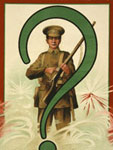At a Glance
Description
Questioning Textbook Authority

Do you teach your students to read documents carefully and critically, but then watch in dismay as they fail to apply these skills while reading their textbooks? As a high school history teacher in Cleveland, Robert Bain did. "The problem," he writes, "was greater than sharpening their tools for critical reading, but rather involved transformation in my students’ relationships to the books, to the historical content in the books, and to the authors who wrote them."
Bain hypothesized that the problem lay in the authority gap between his students and the textbook. History textbooks often take an omniscient tone, smoothing over historical complexities and competing narratives. Students come to most historical topics without enough knowledge to question the textbook account, and they have long been taught to treat their books with deference. Bain developed the following method to raise students’ sense of their own authority so they can read more critically.
1. Students build detailed knowledge before ever opening the textbook.
For a unit on the bubonic plague and the 14th century world, Bain provided his class with a set of "approximately 40 primary sources ranging from woodcuts to papal bulls to stained-glass windows to excerpts of official documents." Over several weeks, the students read the documents, wrote about them in journals, discussed them in groups, and eventually wrote accounts of the plague supported by documentary evidence. With this completed, students read and discussed the account from their textbook. And still they failed to read critically!2. Now experts, students critique the textbook.
Undaunted, Bain gave a carefully worded prompt that explicitly asked students to critique the textbook: "Write a letter to the authors of the text, assessing their [authors'] representations of the plague. Do you think it is an effective representation? Why or why not?" With this encouragement, the floodgates opened, and students criticized the textbook’s limited detail, eurocentrism, simplistic analysis, and lack of context.3. Students question other classroom authorities.
But after this exercise, Bain realized that there still was a source of authority that the students did not question— his own. He pointed out that he had selected the documents, and he asked the students to think about how his own biases might have affected the choices.
This three step method can be adapted to many historical topics. First, locate or assemble a set of documents about an event or era. For ideas, see the Lesson Plans at Teaching with Historic Places, and collections at American Memory, Historical Thinking Matters, or the Teaching and Curriculum Units at the AP United States History Course Home Page and have students construct an account about that event, without consulting the textbook.
Second, ask students to critique the textbook’s account. Third, point out that even their documents were selected by someone, and discuss potential biases in the collection. This last step may seem like a risky move to some teachers, but if it’s a good fit for your class and teaching style, give it a try.
Bain wrote about his method in the Teachers’ College Record, and the article describes, in more depth and detail, his instruction and his students’ work. For those interested in learning more, we highly recommend this piece.
Even when your students have learned historical thinking skills like sourcing and close reading, they may fail to apply them in other contexts, and especially with sources they have learned to view as unquestionable authorities. Bain’s method helps students build global knowledge about a topic and develop enough confidence in their own understanding to overcome the textbook’s authority advantage.
Bain, R. B. Rounding Up Unusual Suspects: Facing the Authority Hidden in the History Classroom. Teachers College Record, 108(10), (2006) 2080-2114.
Also by Bain: Learning to Think Historically: Columbus, Exploration, and the Idea of the Flat Earth